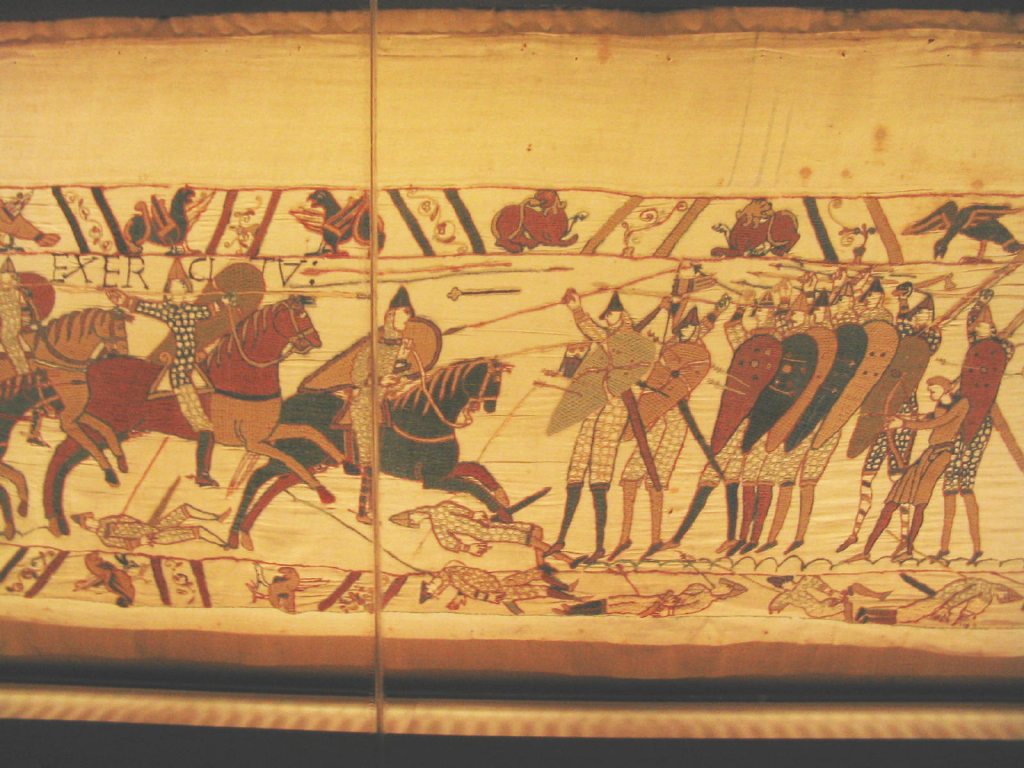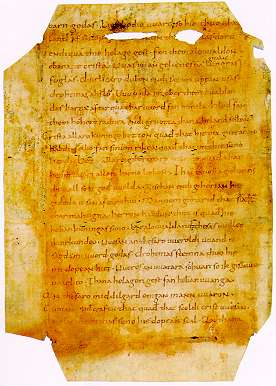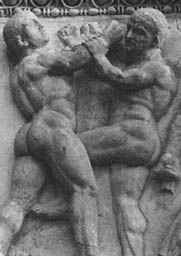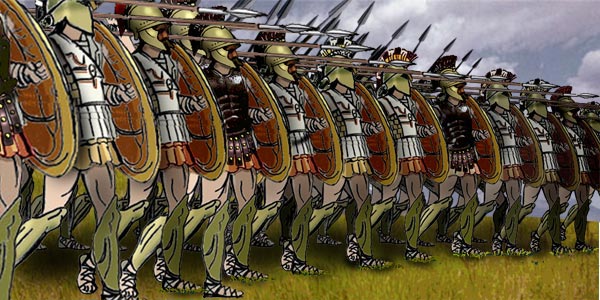|
Phoulkon
The ''phoulkon'' ( gr, φοῦλκον), in Latin fulcum, was an infantry formation utilized by the military of the late Roman and Byzantine Empire. It is a formation in which an infantry formation closes ranks and the first two or three lines form a shield wall while those behind them hurl projectiles. It was used in both offensive and defensive stances. Etymology The term ''phoulkon'' is first attested to in the ''Strategikon of Maurice'', a military manual written in the 590s. Written in Greek, the author of the ''Strategikon'' "also frequently employed Latin and other terms which have been in common military use", as Latin continued to be the language of the army at that time. Therefore, the word, like other military terminology found in the manual, is likely a Greek transliteration of the Latin word ''*fulcum'', though this Latin term is not attested to in any surviving texts. The only other early Byzantine author to use the term was Theophanes the Confessor, who describe ... [...More Info...] [...Related Items...] OR: [Wikipedia] [Google] [Baidu] |
Phalanx
The phalanx ( grc, φάλαγξ; plural phalanxes or phalanges, , ) was a rectangular mass military formation, usually composed entirely of heavy infantry armed with spears, pikes, sarissas, or similar pole weapons. The term is particularly used to describe the use of this formation in ancient Greek warfare, although the ancient Greek writers used it to also describe any massed infantry formation, regardless of its equipment. Arrian uses the term in his ''Array against the Alans'' when he refers to his legions. In Greek texts, the phalanx may be deployed for battle, on the march, or even camped, thus describing the mass of infantry or cavalry that would deploy in line during battle. They marched forward as one entity. The term itself, as used today, does not refer to a distinctive military unit or division (e.g., the Roman legion or the contemporary Western-type battalion), but to the type of formation of an army's troops. Therefore, this term does not indicate a standard comba ... [...More Info...] [...Related Items...] OR: [Wikipedia] [Google] [Baidu] |
Shield Wall
A shield wall ( or in Old English, in Old Norse) is a military formation that was common in ancient and medieval warfare. There were many slight variations of this formation, but the common factor was soldiers standing shoulder to shoulder and holding their shields so that they would abut or overlap. Each soldier thus benefited from the protection of the shields of his neighbors and his own. History Ancient history The formation was known to be used by many ancient armies including the Persian Sparabara, Greek phalanx, and the early Roman army, but its origin and spread is unknown. It may have developed independently more than once. Although little is recorded about their military tactics, the Stele of the Vultures depicts Sumerian soldiers in a shield wall formation during the third millennium BC. By the seventh century BC, shield walls in ancient Greece are well-documented. The soldiers in the shield wall formations were called hoplites, so named for their equi ... [...More Info...] [...Related Items...] OR: [Wikipedia] [Google] [Baidu] |
Latin
Latin (, or , ) is a classical language belonging to the Italic branch of the Indo-European languages. Latin was originally a dialect spoken in the lower Tiber area (then known as Latium) around present-day Rome, but through the power of the Roman Republic it became the dominant language in the Italian region and subsequently throughout the Roman Empire. Even after the fall of Western Rome, Latin remained the common language of international communication, science, scholarship and academia in Europe until well into the 18th century, when other regional vernaculars (including its own descendants, the Romance languages) supplanted it in common academic and political usage, and it eventually became a dead language in the modern linguistic definition. Latin is a highly inflected language, with three distinct genders (masculine, feminine, and neuter), six or seven noun cases (nominative, accusative, genitive, dative, ablative, and vocative), five declensions, four verb conjuga ... [...More Info...] [...Related Items...] OR: [Wikipedia] [Google] [Baidu] |
Old Saxon
Old Saxon, also known as Old Low German, was a Germanic language and the earliest recorded form of Low German (spoken nowadays in Northern Germany, the northeastern Netherlands, southern Denmark, the Americas and parts of Eastern Europe). It is a West Germanic language, closely related to the Anglo-Frisian languages. It is documented from the 8th century until the 12th century, when it gradually evolved into Middle Low German. It was spoken throughout modern northwestern Germany, primarily in the coastal regions and in the eastern Netherlands by Saxons, a Germanic tribe that inhabited the region of Saxony. It partially shares Anglo-Frisian's (Old Frisian, Old English) Ingvaeonic nasal spirant law which sets it apart from Low Franconian and Irminonic languages, such as Dutch, Luxembourgish and German. The grammar of Old Saxon was fully inflected with five grammatical cases ( nominative, accusative, genitive, dative, and instrumental), three grammatical numbers (wikt:singular, ... [...More Info...] [...Related Items...] OR: [Wikipedia] [Google] [Baidu] |
Shield
A shield is a piece of personal armour held in the hand, which may or may not be strapped to the wrist or forearm. Shields are used to intercept specific attacks, whether from close-ranged weaponry or projectiles such as arrows, by means of active blocks, as well as to provide passive protection by closing one or more lines of engagement during combat. Shields vary greatly in size and shape, ranging from large panels that protect the user's whole body to small models (such as the buckler) that were intended for hand-to-hand-combat use. Shields also vary a great deal in thickness; whereas some shields were made of relatively deep, absorbent, wooden planking to protect soldiers from the impact of spears and crossbow bolts, others were thinner and lighter and designed mainly for deflecting blade strikes (like the roromaraugi or qauata). Finally, shields vary greatly in shape, ranging in roundness to angularity, proportional length and width, symmetry and edge pattern; different s ... [...More Info...] [...Related Items...] OR: [Wikipedia] [Google] [Baidu] |
Spatha
The spatha was a type of straight and long sword, measuring between 0.5 and 1 m (19.7 and 39.4 in), with a handle length of between 18 and 20 cm (7.1 and 7.9 in), in use in the territory of the Roman Empire during the 1st to 6th centuries AD. Later swords, from the 7th to 10th centuries, like the Viking swords, are recognizable derivatives and sometimes subsumed under the term ''spatha''. The Roman ''spatha'' was used in war and in gladiatorial fights. The ''spatha'' of literature appears in the Roman Empire in the 1st century AD as a weapon used by presumably Celtic auxiliaries and gradually became a standard heavy infantry weapon, relegating the ''gladius'' to use as a light infantry weapon. The ''spatha'' apparently replaced the ''gladius'' in the front ranks, giving the infantry more reach when thrusting. While the infantry version had a long point, versions carried by the cavalry had a rounded tip that prevented accidental stabbing of the cavalryman's own foot or horse. ... [...More Info...] [...Related Items...] OR: [Wikipedia] [Google] [Baidu] |
Hand-to-hand Combat
Hand-to-hand combat (sometimes abbreviated as HTH or H2H) is a physical confrontation between two or more persons at short range (grappling distance or within the physical reach of a handheld weapon) that does not involve the use of weapons.Hunsicker, A., ''Advanced Skills in Executive Protection'', Boca Raton FL: Universal Publishers, , , p. 51 The phrase "hand-to-hand" sometimes include use of melee weapons such as knives, swords, clubs, spears, axes, or improvised weapons such as entrenching tools. While the term "hand-to-hand combat" originally referred principally to engagements by combatants on the battlefield, it can also refer to any personal physical engagement by two or more people, including law enforcement officers, civilians, and criminals. Combat within close quarters, to a range just beyond grappling distance, is commonly termed close combat or close-quarters combat. It may include lethal and non-lethal weapons and methods depending upon the restrictions impos ... [...More Info...] [...Related Items...] OR: [Wikipedia] [Google] [Baidu] |
Spear
A spear is a pole weapon consisting of a shaft, usually of wood, with a pointed head. The head may be simply the sharpened end of the shaft itself, as is the case with fire hardened spears, or it may be made of a more durable material fastened to the shaft, such as bone, flint, obsidian, iron, steel, or bronze. The most common design for hunting or combat spears since ancient times has incorporated a metal spearhead shaped like a triangle, lozenge, or leaf. The heads of fishing spears usually feature barbs or serrated edges. The word '' spear'' comes from the Old English '' spere'', from the Proto-Germanic ''speri'', from a Proto-Indo-European root ''*sper-'' "spear, pole". Spears can be divided into two broad categories: those designed for thrusting as a melee weapon and those designed for throwing as a ranged weapon (usually referred to as javelins or darts). The spear has been used throughout human history both as a hunting and fishing tool and as a weapon. Along ... [...More Info...] [...Related Items...] OR: [Wikipedia] [Google] [Baidu] |
Martiobarbuli
''Plumbatae'' or ''martiobarbuli'' were lead-weighted darts carried by infantrymen in Antiquity and the Middle Ages. History The first examples seem to have been carried by the Ancient Greeks from about 500 BC onwards, but the best-known users were the late Roman and Eastern Roman armies. The earliest and best written source for these weapons refers to a period around 300 AD, though the document was composed around 390–450 AD. A second source, also from the late 4th century, is an anonymous treatise titled ''De rebus bellicis'', which briefly discusses (so far archaeologically unattested) spiked ''plumbatae'' (''plumbata tribolata''), but which is also the only source that shows an image of what a ''plumbata'' looked like. The image shows what looks like a short arrow with a weight attached to the shaft. Although only later copies of the original manuscript exist, this is confirmed by the remains which have so far turned up in the archaeological record. A third source ... [...More Info...] [...Related Items...] OR: [Wikipedia] [Google] [Baidu] |
Heavy Infantry
Heavy infantry consisted of heavily armed and armoured infantrymen who were trained to mount frontal assaults and/or anchor the defensive center of a battle line. This differentiated them from light infantry who are relatively mobile and lightly armoured skirmisher troops intended for screening, scouting, and other tactical roles unsuited to soldiers carrying heavier loads. Heavy infantry typically made use of dense battlefield formations, such as shield wall or phalanx, multiplying their effective weight of arms with force concentration. Heavy infantry were critical to many ancient armies, such as the Greek hoplites, Macedonian phalangites, and Roman legionaries. After the fall of Rome, heavy infantry declined in Europe but returned to dominance in the Late Middle Ages with Swiss pikemen and German Landsknechts. With the rise of firearms during early modern warfare, dense formations became increasingly hazardous, and heavy armours were either ineffective or too cumberso ... [...More Info...] [...Related Items...] OR: [Wikipedia] [Google] [Baidu] |
Arrow
An arrow is a fin-stabilized projectile launched by a bow. A typical arrow usually consists of a long, stiff, straight shaft with a weighty (and usually sharp and pointed) arrowhead attached to the front end, multiple fin-like stabilizers called fletchings mounted near the rear, and a slot at the rear end called a nock for engaging the bowstring. A container or bag carrying additional arrows for convenient reloading is called a quiver. The use of bows and arrows by humans predates recorded history and is common to most cultures. A craftsman who makes arrows is a fletcher, and one that makes arrowheads is an arrowsmith.Paterson ''Encyclopaedia of Archery'' p. 56 History The oldest evidence of likely arrowheads, dating to c. 64,000 years ago, were found in Sibudu Cave, current South Africa.Backwell L, d'Errico F, Wadley L.(2008). Middle Stone Age bone tools from the Howiesons Poort layers, Sibudu Cave, South Africa. Journal of Archaeological Science, 35:1566–1580. Backwe ... [...More Info...] [...Related Items...] OR: [Wikipedia] [Google] [Baidu] |
Light Infantry
Light infantry refers to certain types of lightly equipped infantry throughout history. They have a more mobile or fluid function than other types of infantry, such as heavy infantry or line infantry. Historically, light infantry often fought as Reconnaissance, scouts, Raid (military), raiders, and skirmisher, skirmishers. These are loose formations that fight ahead of the main army to harass, delay, disrupt supply lines, engage the enemy’s own skirmishing forces, and generally "soften up" an enemy before the main battle. Light infantrymen were also often responsible for Screening (tactical), screening the main body of a military formation. Post-World War II, the term "light infantry" evolved to include rapid-deployment units (including commandos and Airborne forces, airborne units) that emphasize speed and mobility over armor and firepower. Some units or battalions that historically held a skirmishing role have kept their designation "light infantry" for the sake of traditi ... [...More Info...] [...Related Items...] OR: [Wikipedia] [Google] [Baidu] |
.jpg)









